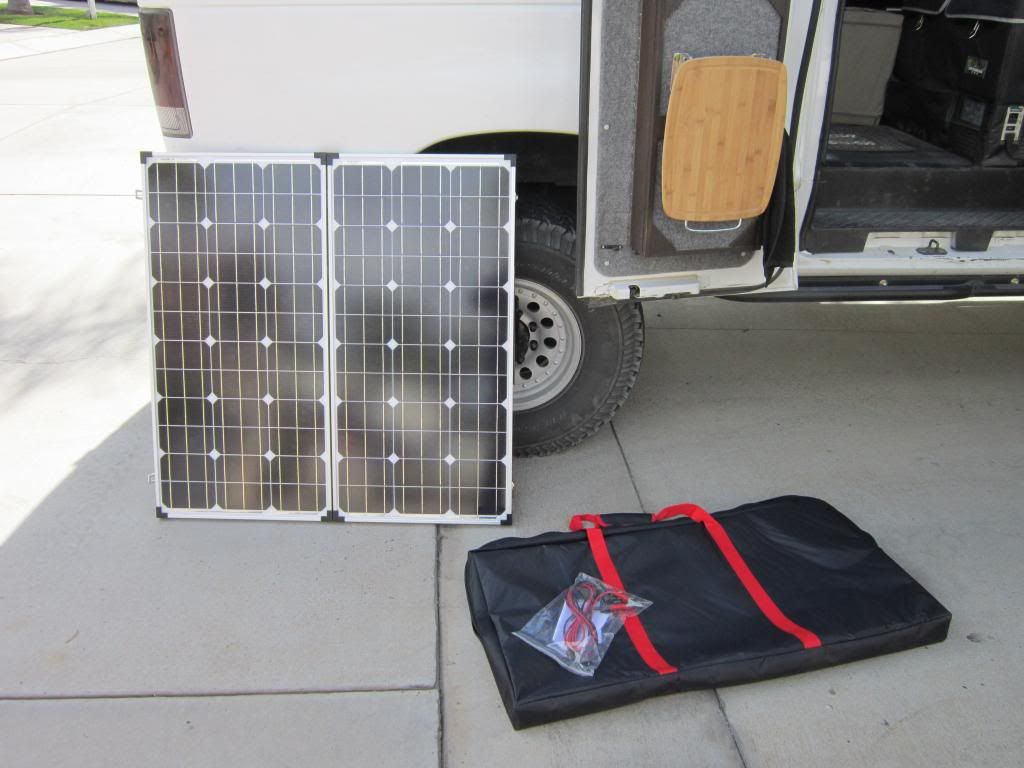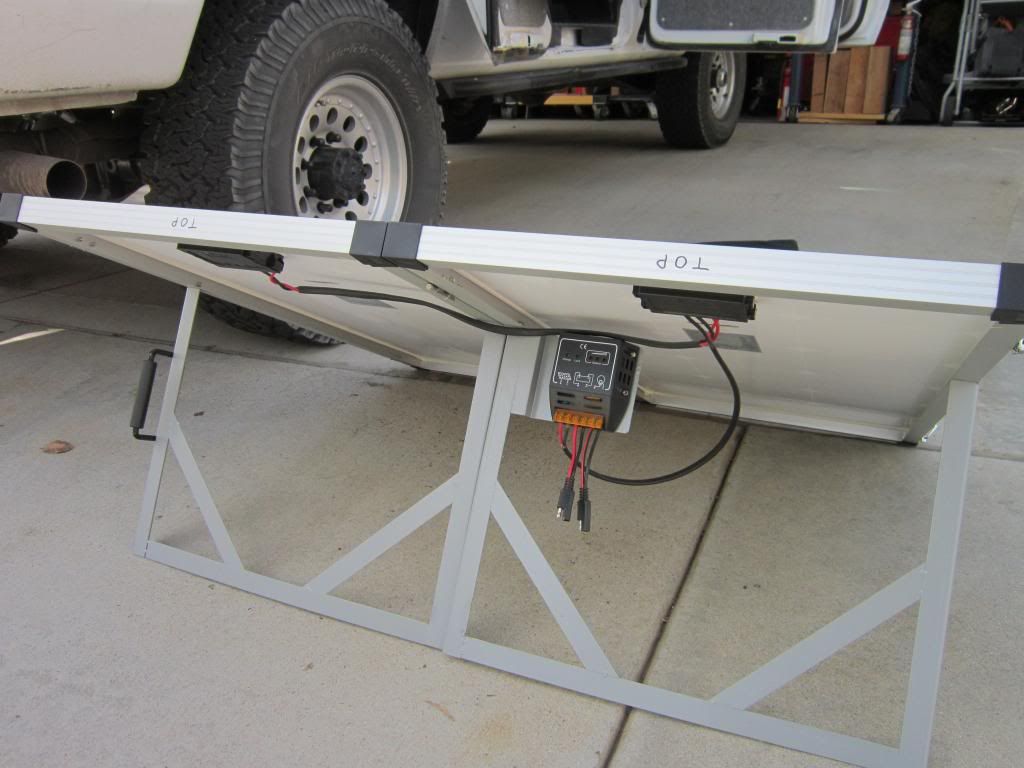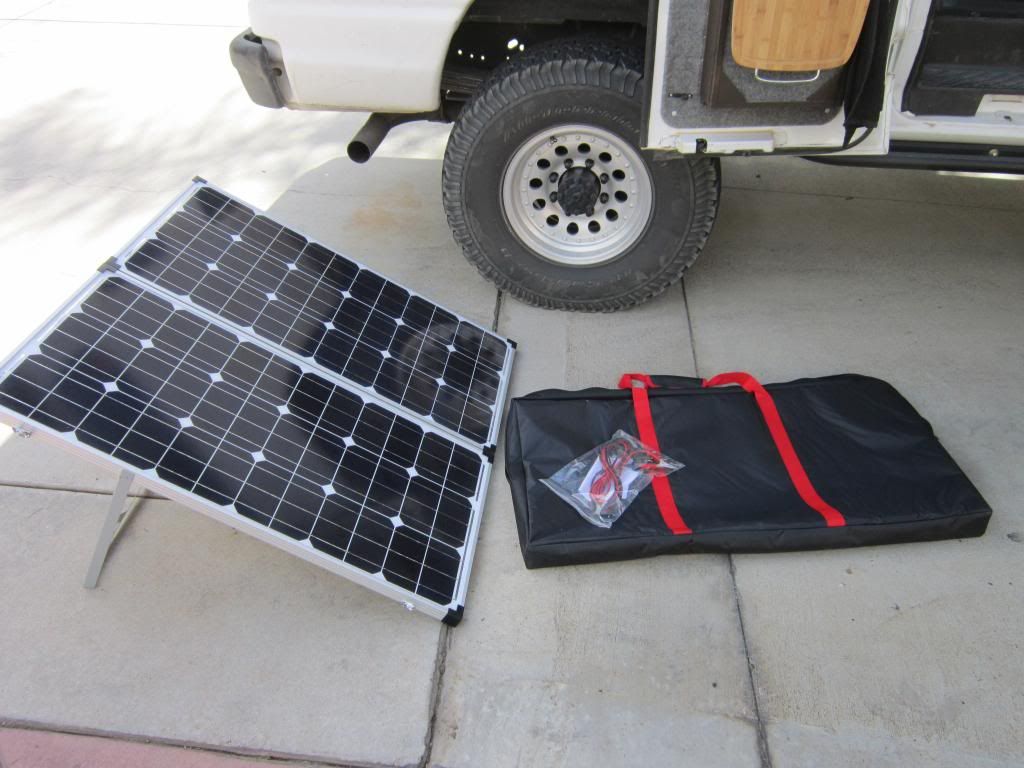You are using an out of date browser. It may not display this or other websites correctly.
You should upgrade or use an alternative browser.
You should upgrade or use an alternative browser.
100W Portable kit on ebay
- Thread starter Dennx
- Start date
arlon
Adventurer
I have a couple other sets of folding panels that did not have cases. It is very easy to create a durable "case" for them. A couple strap buckles, 1" strap, poprivets with washers, neoprene foam padding, Masonite.

Great plan. I like that much better than the case.
HenryJ
Expedition Leader
Thanks! You can tell the little one has been on many trips. The cover works well as a prop as needed tooGreat plan. I like that much better than the case.
HenryJ
Expedition Leader
I never have. Fuses are usually not a bad idea and may not hurt in this case. Keep in mind that in this case we don't want to create any more resistance. We want the charging to be as efficient as possible.1)Should I add a fuse anywhere along the power cord to my main battery?
No worries. It can not pull more than is delivered.2)Is there a risk of starting the truck with the panels attached to the battery?
The idea behind this is to prevent the panels from pulling power. We don't want them to be a heating element grid when the sun goes down. A diode in the charge controller , if functioning properly prevents this. I don't disconnect mine usually.3)Should I disconnect the panels from the battery at night.
My power ports are connected to the battery terminals. I wanted to use them to charge a battery , or "daisy chain" another panel. The load terminals can be used for a light bulb. I believe it bypasses the charge controller. Useful in testing output too, I believe.4)The symbol on the far right of the controller is for a "load" Other than going to my battery with supplied alligator clips what would one use for this? Is this where you have your lighter adaptor going to HenryJ?
Thanks HenryJ and Craig. Makes sense about the fuse and wanting it to be as efficient as it can possibly be. Ill do a voltage check at dawn and again at night Henry to verify this isnt happening with regaurds to the panels sucking on the battery. Id imagine if it were Id have a huge dip in voltage. Good heads up, thanks. Its nice to know nothing can happen with the truck running as well. I realize it defeats the purpose of having both going, but im glad to hear it wont damage anything. Thanks guys for the responses. When it starts to warm up I'm gonna play with this new device. Never ventured with anything like it, but look forward to not havin a weak or dead battery in the bush. Thanks again guys.
Pidge.
Pidge.
HenryJ
Expedition Leader
The key will be chasing the sun. It takes very little light to charge...very little. Changing angle and orientation to get full sun really helps.
Keep in mind that the panels are but one part of the puzzle. The best investment you can make in power is conservation. LED lighting is a good investment. Limit conversions. An inverter wastes power. It is more efficient to use DC directly. Heat with gas. Use gravity and man power to pump water when possible. We have a hand pump deck sprayer mounted in the back of the truck. The wand is short and mounted on the bumper. This is our hand washing station. Works for a little water to brush teeth with too. Less water for the 12v pump to move. Every little bit of conservation helps.
Next is storage. A bigger battery bank is a good thing to have. I run two 6v golf cart batteries. You need to have a large enough reserve to serve your needs and leave room so that it is not completely discharged. I don't recall the numbers off the top of my head, but a certain percentage depletion cycle is recommended for optimum performance. I like to try to keep it so that it takes only half my sun to recharge the bank of batteries each day. I am happy if I am recharged before or by noon each day.
It is a balancing act. Put the weight where it is needed to make it all work together.
Keep in mind that the panels are but one part of the puzzle. The best investment you can make in power is conservation. LED lighting is a good investment. Limit conversions. An inverter wastes power. It is more efficient to use DC directly. Heat with gas. Use gravity and man power to pump water when possible. We have a hand pump deck sprayer mounted in the back of the truck. The wand is short and mounted on the bumper. This is our hand washing station. Works for a little water to brush teeth with too. Less water for the 12v pump to move. Every little bit of conservation helps.
Next is storage. A bigger battery bank is a good thing to have. I run two 6v golf cart batteries. You need to have a large enough reserve to serve your needs and leave room so that it is not completely discharged. I don't recall the numbers off the top of my head, but a certain percentage depletion cycle is recommended for optimum performance. I like to try to keep it so that it takes only half my sun to recharge the bank of batteries each day. I am happy if I am recharged before or by noon each day.
It is a balancing act. Put the weight where it is needed to make it all work together.
LandCruiserPhil
Expedition Leader
The key will be chasing the sun. It takes very little light to charge...very little. Changing angle and orientation to get full sun really helps.
Keep in mind that the panels are but one part of the puzzle. The best investment you can make in power is conservation. LED lighting is a good investment. Limit conversions. An inverter wastes power. It is more efficient to use DC directly. Heat with gas. Use gravity and man power to pump water when possible. We have a hand pump deck sprayer mounted in the back of the truck. The wand is short and mounted on the bumper. This is our hand washing station. Works for a little water to brush teeth with too. Less water for the 12v pump to move. Every little bit of conservation helps.
Next is storage. A bigger battery bank is a good thing to have. I run two 6v golf cart batteries. You need to have a large enough reserve to serve your needs and leave room so that it is not completely discharged. I don't recall the numbers off the top of my head, but a certain percentage depletion cycle is recommended for optimum performance. I like to try to keep it so that it takes only half my sun to recharge the bank of batteries each day. I am happy if I am recharged before or by noon each day.
It is a balancing act. Put the weight where it is needed to make it all work together.
^^^Good advice^^^conservation
RangerXLT
Adventurer
Alright question guys: I'm going to purchase the 120watt panel as well, but I was wondering if there was a good way to hard wire this to the house battery and run a quick connection to perhaps the front bumper (female end)and then wire the other end(male) to the solar panel wiring. Essentially the goal here is to unload my panel, set it up and the connect it without popping the good and using alligator clips.
dstock
Explorer
Alright question guys: I'm going to purchase the 120watt panel as well, but I was wondering if there was a good way to hard wire this to the house battery and run a quick connection to perhaps the front bumper (female end)and then wire the other end(male) to the solar panel wiring. Essentially the goal here is to unload my panel, set it up and the connect it without popping the good and using alligator clips.
Because I needed a quick solution to the same question you posed, I used a universal trailer wiring harness plug setup from the local auto store. Wired one end to the battery with the plug on the bumper and the other to wiring for the panel. Worked great and although it was a temp solution at the time, I actually haven't found a reason to re-do it. Can take a pic if you like.
RangerXLT
Adventurer
Because I needed a quick solution to the same question you posed, I used a universal trailer wiring harness plug setup from the local auto store. Wired one end to the battery with the plug on the bumper and the other to wiring for the panel. Worked great and although it was a temp solution at the time, I actually haven't found a reason to re-do it. Can take a pic if you like.
Yeah please do. I was just wanting to make sure that it wouldn't cause any issues.
Sent from my iPad using Tapatalk



